Page 14 of 273

Pre-Drive Safety Checklist
To make sure you and your
passenger get the maximum
protection from your car's safety
features, check the following each
time before you drive
away:
• You and any adult passenger, or a
larger child who has outgrown
child seats, are wearing your seat
belts and wearing
them properly
(see page
15 ) .
• A small child riding in a forward
facing child seat is properly
restrained (see page
26).
• Occupants are sitting upright and
as far back as possible from
the
steering wheel and dashboard
(see page
12 ) .
• Seat-backs are upright (see page
13 ).
• Both doors are closed and locked
(see page
12 ).
• All cargo is properly stored or
secured (see page 124).
The rest of this section gives more
detailed information about how you
can maximize your safety.
Remember, however, that
no safety
system can prevent
all injuries or
deaths that can occur in severe
crashes, even when seat belts are
properly worn and the air bags deploy.
Your Car's Safety Features
Driver and Passenger Safety 11
Page 15 of 273

Protecting Adults
Introduction
The following pages provide
instructions on how to properly
protect adult occupants.
These instructions also apply to a
child whom you have decided is
large enough and mature enough to
ride as a passenger. (See page
29 for
important additional guidelines on
how to properly protect larger
children.)
1. Close and Lock the Doors
After everyone has entered the car,
be sure the doors are closed and
locked.
12
Driver and Passenger Safety
~ Your car has a door
~ monitor light on the
instrument panel to indicate when a
specific door is
not tightly closed.
For safety, locking the doors reduces
the chance
that a passenger,
especially a child,
will open a door
while the car is moving and
accidentally fall out.
It also reduces
the chance of someone being thrown
out of the car during a crash.
For security, locked doors can
prevent an outsider from
unexpectedly opening a door when
you come to a stop.
See page
58 for how to lock the
doors.
2.Adjust the Front Seats
Any driver who sits too close to the
steering wheel is at risk of being
seriously injured or killed by striking
the steering wheel,
or from being
struck by an inflating airbag during a
crash.
Page 18 of 273
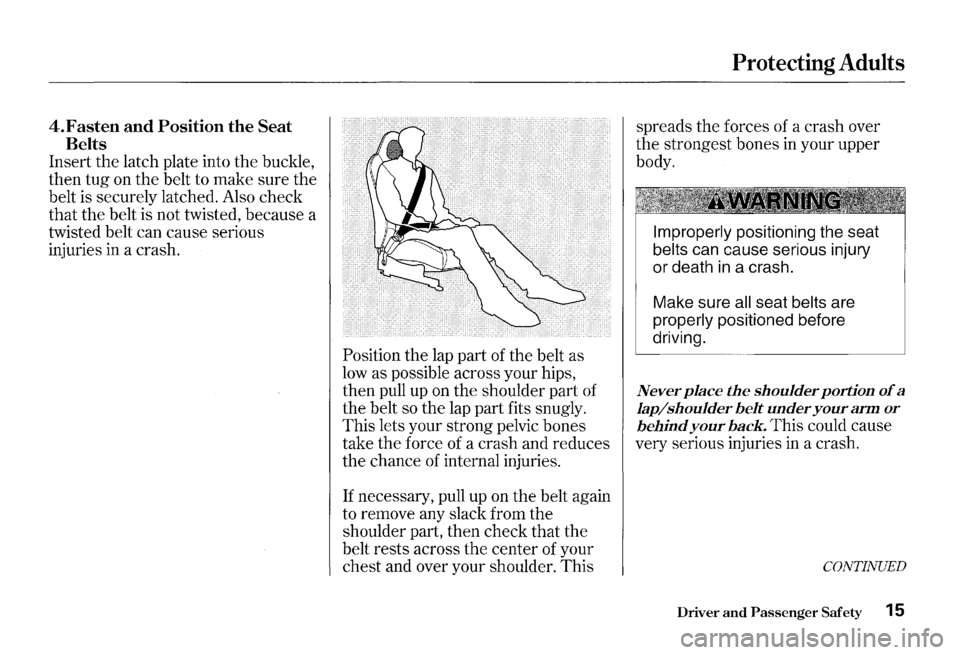
4.Fasten and Position the Seat
Belts
Insert the latch plate into the buckle,
then tug on the belt to make sure the
belt is securely latched. Also check
that the belt is not twisted, because a
twisted belt can cause serious
injuries in a crash.
Position the lap part of the belt as
low as possible across your hips,
then pull up on the shoulder part of
the belt so the lap part fits snugly.
This lets your strong pelvic bones
take the force of a crash and reduces
the chance of internal injuries.
If necessary, pull up on the belt again
to remove any slack from the
shoulder part, then check that the
belt rests across the center of your
chest and over your shoulder. This
Protecting Adults
spreads the forces of a crash over
the strongest bones
in your upper
body.
Improperly positioning the seat
belts can cause serious injury
or death
in a crash.
Make sure
all seat belts are
properly positioned before
driving.
Never place the shoulder portion of a
lap/shoulder belt under your arm or
behind your back. This could cause
very serious injuries
in a crash.
CONTINUED
Driver and Passenger Safety 15
Page 27 of 273
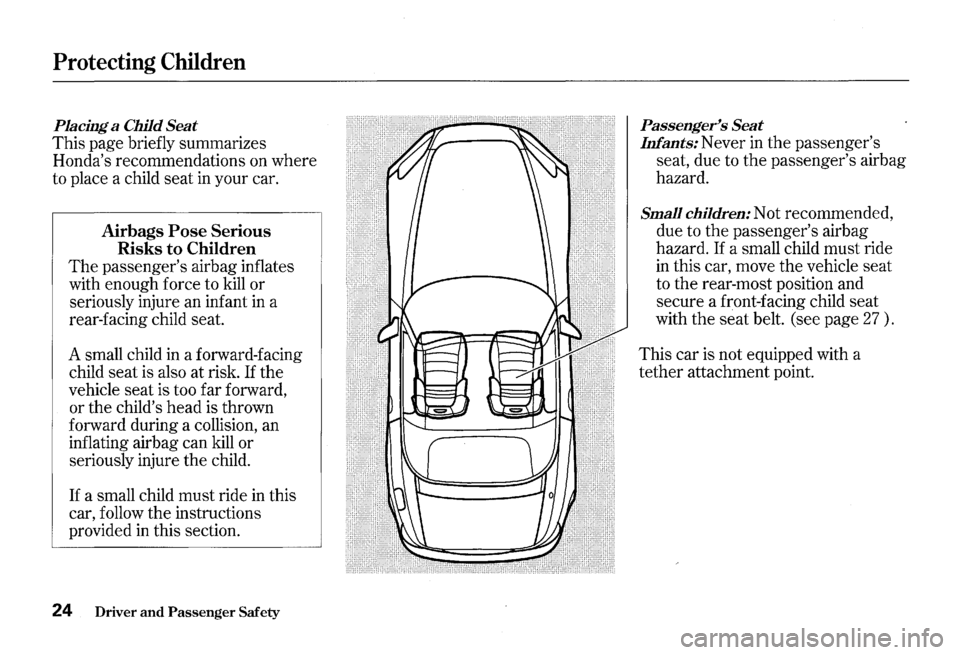
Protecting Children
Placing a Child Seat
This page briefly summarizes
Honda's recommendations on where
to place a child seat in your car.
Airbags Pose Serious
Risks to Children
The passenger's airbag inflates
with enough force to kill or
seriously injure an infant in a
rear-facing child seat.
A small child
in a forward-facing
child seat is also at risk.
If the
vehicle seat is too far forward,
or the child's head is thrown
forward during a collision, an
inflating airbag can kill or
seriously injure the child.
If a small child must ride in this
car, follow the instructions
provided in this section.
24 Driver and Passenger Safety
Passenger's Seat
Infants: Never in the passenger's
seat, due to
the passenger's airbag
hazard.
Small children: Not recommended,
due to
the passenger's airbag
hazard.
If a small child must ride
in this car, move the vehicle seat
to the rear-most position and
secure a front-facing child seat
with
the seat belt. (see page 27).
This car is not equipped with a
tether attachment point.
Page 28 of 273
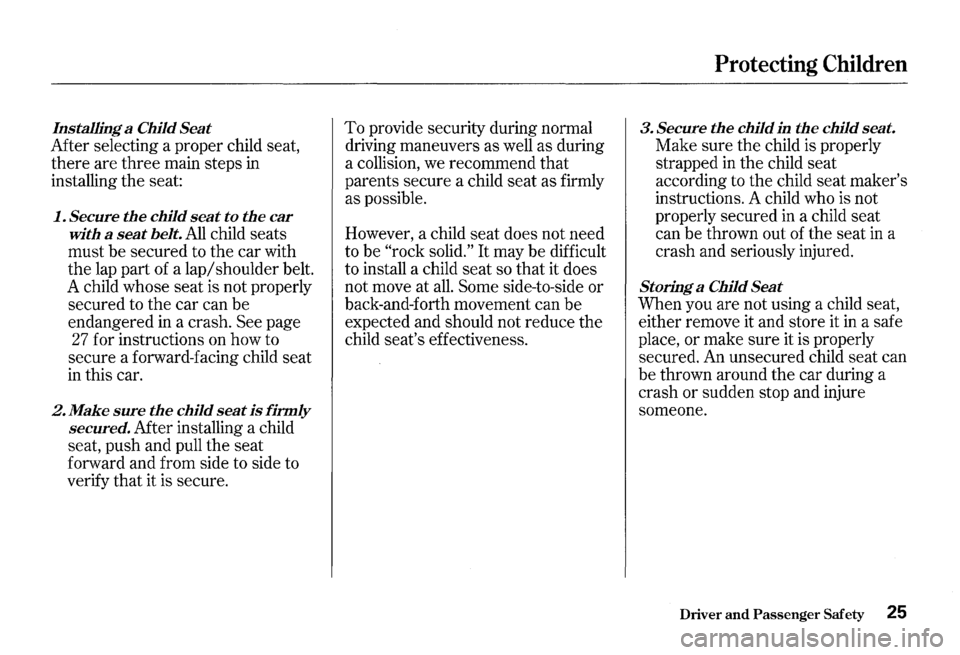
Installing a Child Seat
Mter selecting a proper child seat,
there are three main steps in
installing the seat:
1. Secure the child seat to the car
with a
seat belt. All child seats
must be secured to the car with
the lap part of a lap/shoulder belt.
A child whose seat is not properly
secured to
the car can be
endangered
in a crash. See page
27 for instructions on how to
secure a forward-facing child seat
in this car.
2. Make sure the child seat is firmly
secured. Mter installing a child
seat, push and pull the seat
forward and from side to side to
verify that it is secure. To
provide security during normal
driving maneuvers as well as during
a collision, we recommend that
parents secure a child seat as firmly
as possible.
However, a child seat does not need
to be
"rock solid." It may be difficult
to install a child seat so that it does
not move at
all. Some side-to-side or
back-and-forth movement can be
expected and should not reduce the
child seat's effectiveness.
Protecting Children
3. Secure the child in the child seat.
Make sure the child is properly
strapped in the child seat
according to
the child seat maker's
instructions. A child who is not
properly secured in a child seat
can be thrown out of the seat
in a
crash and seriously injured.
Storing a Child Seat
When you are not using a child seat,
either remove it and store it in a safe
place, or make sure it is properly
secured. An unsecured child seat can
be thrown around the car during a
crash or sudden stop and injure
someone.
Driver and Passenger Safety 25
Page 30 of 273
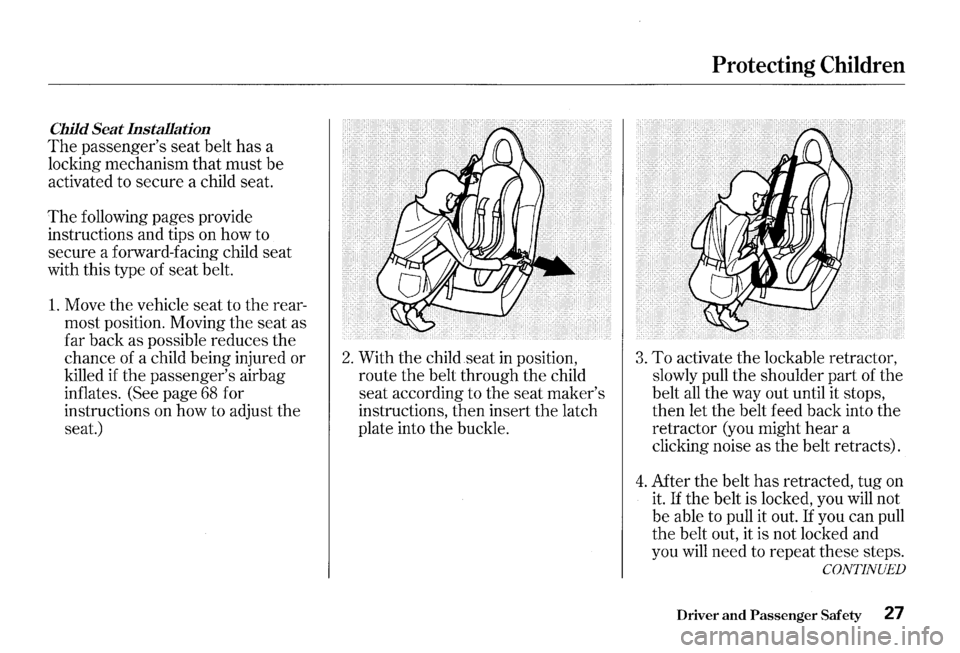
Child Seat Installation
The passenger's seat belt has a
locking mechanism that must be
activated to secure a child seat.
The following pages provide
instructions and tips on how to
secure a forward-facing child seat
with this type of seat belt.
1. Move the vehicle seat to the rear
most position. Moving the seat as
far back as possible reduces the
chance of a child being injured or
killed
if the passenger's airbag
inflates. (See page
68 for
instructions on how to adjust the
seat.)
2. With the child seat in position,
route the belt through the child
seat according to the seat maker's
instructions, then insert the latch
plate into the buckle.
Protecting Children
3. To activate the lockable retractor,
slowly pull the shoulder part
of the
belt
all the way out until it stops,
then let the belt feed back into the
retractor (you might hear a
clicking noise as the belt retracts).
4. After the belt has retracted, tug on
it. If the belt is locked, you will not
be able to pull it out.
If you can pull
the belt out, it is not locked and
you
will need to repeat these steps.
CONTINUED
Driver and Passenger Safety 27
Page 31 of 273
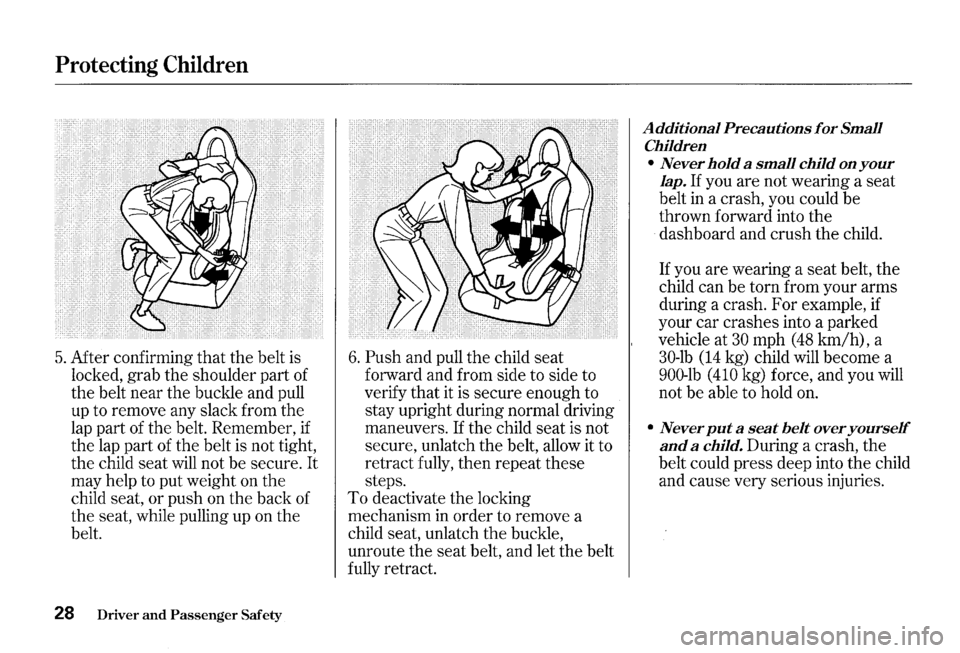
Protecting Children
5. After confirming that the belt is
locked, grab the shoulder part of
the belt near the buckle and pull
up to remove any slack from the
lap part of the belt. Remember,
if
the lap part of the belt is not tight,
the child seat
will not be secure. It
may help to put weight on the
child seat, or push on the back of
the seat, while pulling up on the
belt.
28 Driver and Passenger Safety
6. Push and pull the child seat
forward and from side to side to
verify that it is secure enough to
stay upright during normal driving
maneuvers.
If the child seat is not
secure, unlatch the belt, allow it to
retract fully,
then repeat these
steps.
To deactivate the locking
mechanism
in order to remove a
child seat, unlatch
the buckle,
unroute the seat belt, and let the belt
fully retract.
Additional Precautions for Small
Children
• Never hold a small child on your
lap. If you are not wearing a seat
belt
in a crash, you could be
thrown forward into the
dashboard and crush the child.
If you are wearing a seat belt, the
child can be torn from your arms
during a crash. For example,
if
your car crashes into a parked
vehicle at
30 mph ( 48 km/h), a
30-lb (14 kg) child will become a
900-lb (410 kg) force, and you will
not be able to hold on.
• Never put a seat belt over yourself
and a child. During a crash, the
belt could press deep into the child
and cause very serious injuries.
Page 35 of 273
Protecting Children
If you decide that a child can safely
ride in this car, be sure to:
• Carefully read the owner's manual
and make sure you understand
all
seat belt instructions and all safety
information.
• Move the vehicle seat to the rear
most position.
• Have the child sit up straight, back
against the seat, and feet on or
near the floor.
• Check that the child's seat belt is
properly positioned and secured.
32 Driver and Passenger Safety
• Supervise the child. Even a mature
child sometimes needs to be
reminded to fasten the seat belt or
sit properly.